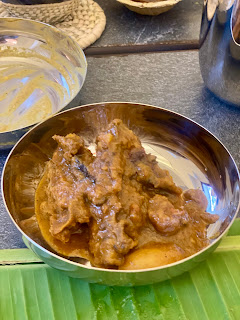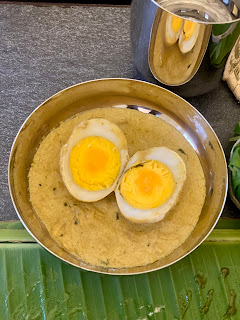#blahvsfood on Amar Khamar… and why it’s one of the most important brands and dining spaces in India today.
Amar Khamar is one of the most important brands in Indian food today. It is a store, a website and a restaurant.And it is also the space where I had one of the most memorable Bengali meals of my life.
Amar Khamar started as a social enterprise that aims to create a culture of biodiverse, seasonal, home-cooked and conscious eating as a way of life. They work with a large number of small farmers, growers and cultivators across Bengal to source and preserve native ingredients and indigenous varietals.
They sell over a hundred items including thirty nine varieties of heirloom rice, seven kinds of dal, fourteen kinds of honey and gur, and several kinds of ghee, handmade masalas, flours, grains and more. All of this is now available in a store as well as on a website (amar khamar ) that delivers nationally.
However as part of this journey, what they realised is that the cultural memory of eating this food was starting to disappear. People have become so used to cooking and eating mass produced, industrially farmed or processed food that they don’t really know what to do with Burma Black rice, or a light fragrant ghee from Kalimpong, or a Kolai dal.
So they created a dining space where you can actually see these ingredients cooked in classic, simple Bengali food. This isn’t the Bengali food you’re familiar with at Oh Calcutta or 6 Ballygunge. This is food from homes and food from the humble pice hotels (which I truly believe is where you get the best Bengali food), but served in a more elegant way and broken into four courses.
I actually shouldn’t say courses because that conjures images of set menus and individual courses. This is more like four movements or stages. At the heart of every stage is a rice . This is accompanied by a bunch of dishes based on a theme. First the bitter, then the dal with bhaja and torkari. The third progression is meat, fish and egg. All the savoury courses are accompanied by a ghee that does justice to the rice varietal and the dishes. And then finally we move to chutney and desserts, both a payesh and a mishti doi.
The dishes were amazing. We must have had some twelve (or more) dishes, many of which I hadn’t tried before. The ones I had tried earlier evoked long lost childhood memories and I felt them emotionally and not just as taste. There was a mixed vegetable dish with watermelon rind and fried leafy greens with raw mango in mustard sauce. The Bengali philosophy of no waste was showcased in a delicious paste made from local pointed gourd peel. There was duck egg cooked with poppy seed paste. And instead of kosha mangsho or mangsho’r jhol, there was a spicy goat dish with Chui Jhal (a peppery vine from South Bengal), and Chui jhal pickle.
But the star of the meal was rice. It was a meal that made me realise the soul of Bengal lies in its paddy fields. Bengalis are often caricatured for their love of fish but it is rice, with its endless varieties, hyper local in a way we never realise, that is the beating heartbeat of Bengali cuisine.
Eating this food is a privilege.
It’s an act that is loaded with impact and significance. One that forms a bridge between our roots and the future, an essential act when consumerism and the culture of consumption leads to the erasure of the past and the homogenisation of the present. Where mass production is wiping out jobs, communities and entire ways of life, consigning them to archival relics rather than a pathway to a sustainable future.
This may seem like a shop and a restaurant.
But it’s a pathway to a better world.
And it just maybe a revolutionary moment.
The meal:
Chhuti-r Bhat (Holiday Meal)
1. Sugondhi Chine Kamini Aatap | Bhat
Aromatic rice (Chine Kamini variety)
2. Tormuj-er Shukto | Teto
Bitter mixed vegetable dish with watermelon rind | Bitter item
3. Shak Bhaja, Ghor-e Banano Aam Sorshe | Shak
Fried greens, Homemade raw mango in mustard sauce | Greens
4. Deshi Potol-er Khosa Bata | Bata
Paste made from local pointed gourd peel | Paste
5. Soru Siddho Lal-Sada Dudher-sar | Bhat
Soft-cooked red and white rice with milk cream | Rice
6. Pat Pata-r Bora | Bhaja
Deep-fried fritters made from leaves | Fried item
7. Aam Diye Masur-er Tok Dal | Dal
Sour lentil soup made with raw mango and red lentils | Dal
8. Dudh Potol, Sorshe | Torkari
Pointed gourd in a milk and mustard gravy | Vegetable curry
⸻
Soru Sidhho Mohonshal | Bhat
Soft-boiled rice (I forget which specific variety) | Rice
⸻
Dim, Mach & Mangso – choose any two (Egg, Fish & Meat – choose any two)
• Campbell Hans-er Dim Posto
Duck egg cooked with poppy seed paste
• Pabda Macher Tel Jhol
Pabda fish in a mustard-oil based light curry
• Deshi Murgi-r Jhol, Uttorbango-r Badami Aalu
Country chicken curry with North Bengal-style creamy potato curry
• Amar Khamar’s special Chui Jhal Mangso, Chui Jhal Aachar
Farm-special spicy meat with Chui Jhal (a peppery vine from South Bengal), and Chui Jhal pickle
⸻
Knacha Aam-er Tok | Tok
Raw mango sour chutney | Chutney
⸻
Tal-er Gur Makha Ghor-e Pata Doi | Mishti
Palm jaggery mixed with homemade leaf-curd yogurt | Dessert
Badshahbhog Chal-er Payes | Mishti
Rice pudding made with aromatic Badshahbhog rice | Dessert
with this season’s Tal Gur from North 24-Parganas











Comments